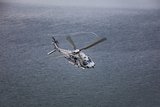New MEDEVAC helicopters take flight in Iraq
The Army's newest MEDEVAC helicopter is seeing action for the first time in Iraq while serving as a test bed with a Vermont National Guard aviation company.
The Soldiers of C company, 3rd Battalion, 126th Aviation Regiment, deployed in November with a dozen HH-60M MEDEVAC helicopters, the latest medical variant of the Army's Black Hawk airframe.
In addition to their MEDEVAC mission, the unit's crews are working with representatives from Sikorsky Aircraft Corporation to work through the kinks of the aircraft's new systems.
Already the new bird is popular with crew.
"It's like going from a '67 Buick to jumping into a brand new Cadillac," said Sgt. David Diminico, an HH-60M crewmember.
The MEDEVAC features include an integrated EKG machine, an oxygen generator, electronically controlled litters, an infrared system that can locate patients by their body heat and a built-in, external hoist.
"There's a lot of the stuff built into this aircraft that we used to have to carry out to the aircraft," said Diminico. "We've got everything we need in one aircraft, and we can get off of the ground pretty quickly."
That means the world to MEDEVAC crews, he said. On an urgent call, crews must take off in under 15 minutes. Every minute carrying and assembling gear adds to that time. With the HH-60M, C Company recently launched in less than seven minutes.
"When you're talking about our flight medics getting there, 30 seconds can make a huge difference," said Diminico.
Performance-wise the HH-60M is an upgraded derivative of the UH-60M Black Hawk featuring more powerful engines, improved rotor blades, electronic instrumentation, digital displays and an autopilot feature. It also has new features that enhance its medical mission.
The aircraft's digital-age look extends from the cockpit to the crew area, setting the HH-60M apart from some of its more rugged looking predecessors. The crew chiefs' seats have moved to the very back of the aircraft, making room for up to six patients and a myriad of technological gadgets. The crew can easily access litters and other medical equipment from their seats.
From the outside, one of the more noticeable differences is the absence of open crew chief windows. The crews now use plastic bubbles protruding from the aircraft's doors. The sealed windows help the crews maintain a sterile environment, said Diminico.
The HH-60M will be put to use with the company for the next year. The Army will continue to field the HH-60M to its fleet, incorporating lessons learned from the company's deployment.
Source: The Army News Service
More from Defence Helicopter
-
![Germany to send WS-61 Westland Sea King helicopters to Ukraine]()
Germany to send WS-61 Westland Sea King helicopters to Ukraine
Germany has committed to sending Ukraine six of its 21 retiring WS-61 Westland Sea King multirole, amphibious helicopters.
-
![Boeing secures $271 million to advance modernisation of US Special Operations' MH-47G Chinook]()
Boeing secures $271 million to advance modernisation of US Special Operations' MH-47G Chinook
Boeing has clinched a major contract modification to further its backing of the US Special Operations Command’s MH-47G Chinook aircraft modernisation effort.
-
![Dubai Airshow 2023: South Korean homegrown helicopters make international debut]()
Dubai Airshow 2023: South Korean homegrown helicopters make international debut
Two KAI helicopters, the KUH-1E utility helicopter and the Light Attack Helicopter (LAH), have taken centre stage at the Dubai Airshow 2023.
-
![Italian Navy receives final NH90 helicopter]()
Italian Navy receives final NH90 helicopter
The Italian Navy now boasts a fleet of 56 NH90 helicopters comprising 46 SH-90As and 10 MH-90As.
-
![Argentina seeks AW109 and CH-46 Sea Knight helicopters]()
Argentina seeks AW109 and CH-46 Sea Knight helicopters
The Argentinian Air Force (FAA) and the Argentinian Naval Aviation Command (COAN) are looking for options to upgrade their helicopter fleets.
-
![DSEI 2023: Lockheed to produce about 40% of Black Hawks on UK soil if it wins NMH contest]()
DSEI 2023: Lockheed to produce about 40% of Black Hawks on UK soil if it wins NMH contest
Lockheed Martin promises a boost to the British job market and export opportunities, while strengthening ties with Poland and positioning the UK for a future in rotorcraft technology in the event of a New Medium Helicopter competition triumph.


























